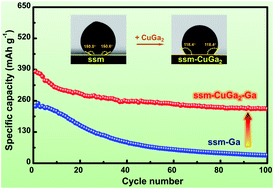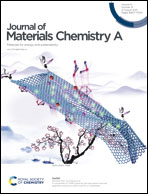Self-healing liquid Ga-based anodes with regulated wetting and working temperatures for advanced Mg ion batteries†
Abstract
Alloy-type anodes for magnesium ion batteries (MIBs) have aroused great interest because of their high specific capacities and potential compatibility with conventional electrolytes. Nevertheless, the huge volume variations associated with alloying/dealloying processes result in their poor cycle life. Herein, liquid gallium (Ga) electrodes with self-healing properties were simply fabricated by painting onto stainless steel mesh (ssm), but show unsatisfactory cycling stability due to the poor wettability of liquid Ga on the substrate. To address this issue, a CuGa2 layer was constructed on the surface of ssm and the wettability of liquid Ga on the ssm substrate was significantly enhanced. As compared with the ssm-Ga electrode, the ssm-CuGa2-Ga anode displays much better electrochemical performance towards Mg storage. Moreover, ex situ scanning electron microscopy and operando X-ray diffraction were performed to clarify the Mg storage mechanism and the self-healing properties of the liquid Ga anode during the discharge/charge processes. Noticeably, the liquid Ga electrode exhibits good compatibility with conventional Mg salt electrolytes such as Mg(TFSI)2. Additionally, the working temperature range of liquid Ga-based anodes could be largely expanded by introducing alloying elements such as tin (Sn) and/or indium (In).



 Please wait while we load your content...
Please wait while we load your content...